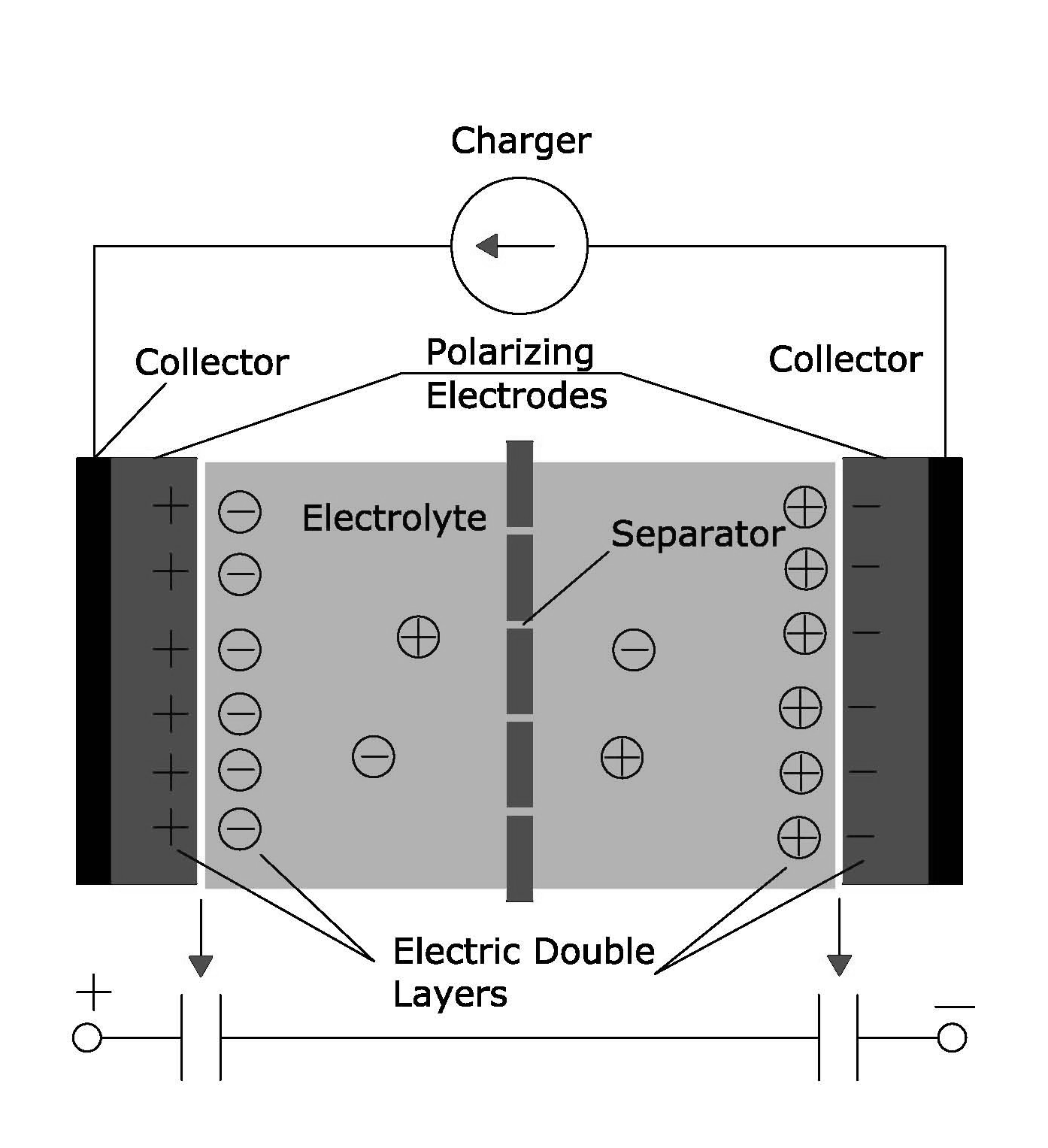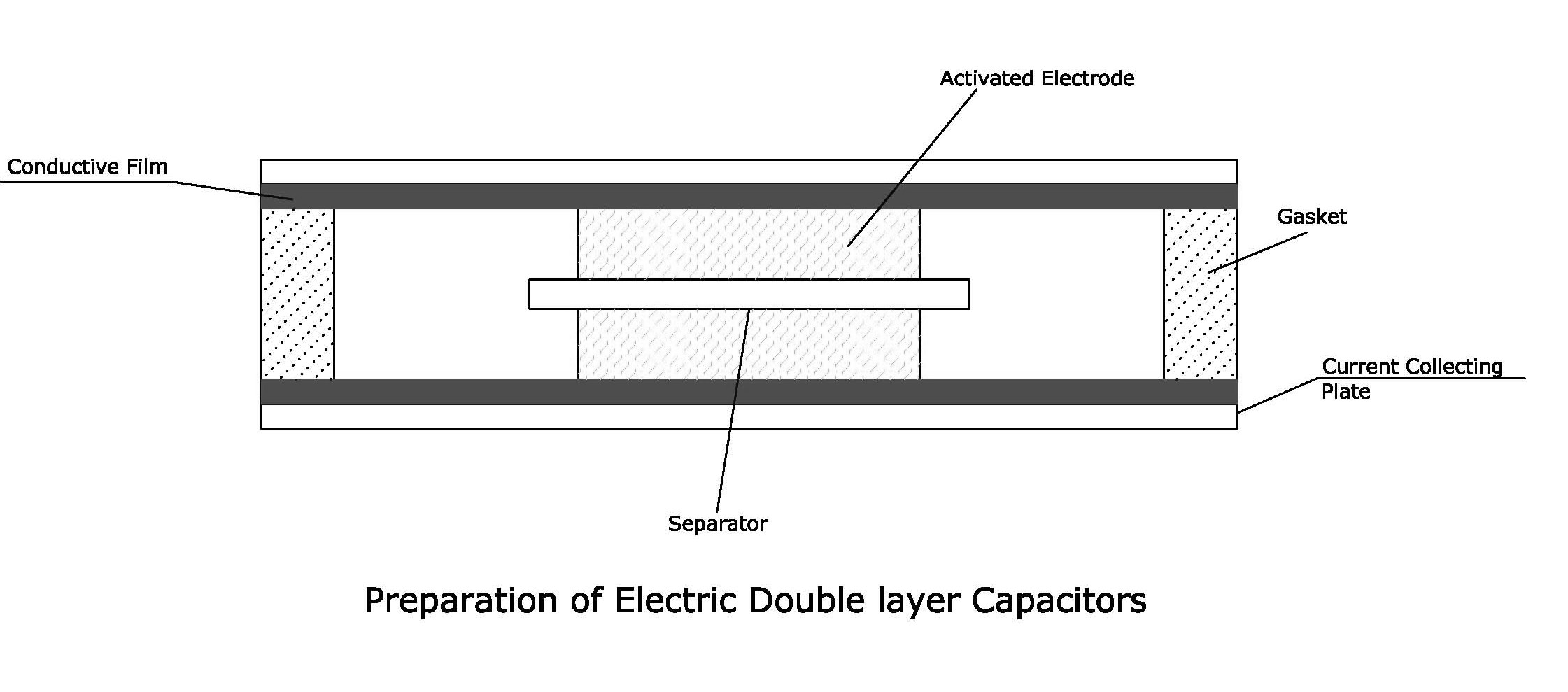
4. Double layer capacitors
Electric/electrochemical double layer capacitor (EDLC) is a unique electrical storage device, which can store much more energy than conventional capacitors and offer much higher power density

Figure 3. Typical configuration of an EDLC cell
There are two general directions of interest. One is the long term goal of the development of electrical propulsion for vehicles, and the other is the rapid growth of portable electronic devices that require power sources with maximum energy content and the lowest possible size and weight [9].
4.1. Electric double layer capacitor
Electric double layer capacitors (EDLCs) are defined as a sort of physical battery [38]. The
EDLC has a pair of polarizable electrodes with collector electrodes, a separator, and an electrolyte
solution. Fig. 4 shows the ideal lab-scale construction of an EDLC cell. The capacitor is charged and the electrical energy stored in the capacitor is discharged at loads. An outline on the development, history and EDLC characteristics developed for power uses “UP-Cap” is described in brief in a review paper by S. Nomoto et al [11]. EDLCs based on carbon electrodes has been used for memory back-up device since 1978 for many electrical appliances like VCRs, camera etc. In 1980s, the EDLCs were used for the energy source to drive wrist watches with solar cells. In 1990s, they were used as actuator back-up sources for toys, electric appliances, home equipment etc. Recently, EDLCs with higher capacitances are under development for higher electric power sources in electric vehicle systems and electric power storage systems. Another interesting review on carbon materials that are used as electrodes in EDLCs is written by E. Frackowiak and F. Béguin; they have discussed about the different forms of carbon such as carbon aerogels, activated carbon and carbon nanotubes being used as the electrodes in EDLCs [10]. Typical electrochemical response of carbon nanotube in aqueous electrolyte is shown in Fig. 5 where the symmetrical and rectangular cyclic voltammetric curve is a trademark for double layer capacitance [39]. Theoretically, specific capacitance of an activated carbon is directly proportional to the specific surface area. However, in reality it does not happen. It was reported that the some activated carbons with smaller surface area give a larger specific capacitance
than those with a larger surface area; for instance, M-30 with a BET surface area of 2571 m2/g gave
the specific capacity of 62.9 Fg-1 while M-30 with a BET surface area of 2130 m2/g gave a specific capacity of 100 Fg-1 [40]. The relation between the surface area of the activated carbons and their electrochemical performance has been discussed by Shi et al [40, 41].

On the influence of physical properties of activated carbons on the behavior of EDLCs, it was reported by M. Nakamura et al that the rest potential was not influenced by the precursors (phenolic resin, mineral oil, coconut shell and coal) or manufacturing methods and the electrochemical characteristics of the activated carbons depend on the oxygen content and the concentration of acidic surface functional groups [42]. For a series of nanopororus activated carbons prepared from bituminous coal, it was found that the gravimetric capacitance in KOH electrolyte depended not only
on the surface area of the activated carbons but also on the higher oxygen content [43]. However, it was shown that the electrochemical capacitance of nanoporous carbons also depends on the electrolyte; carbon nanotubes with micropores have higher capacitance in aqueous electrolytes while carbon aerogel with macropores have higher capacitance in ionic liquids. This fact implies that the specific capacitance of porous carbon depends on its matching degree to the applied electrolytes rather than its overall pore volume [44]. In another singularly interesting work, 25 samples of porous carbon materials were prepared from three different precursors and activated in alkali solution. The samples chemically activated with KOH were found to have higher oxygen content than the NaOH; a very good correlation between specific capacitance and CO-type oxygen groups has been found [45]. An elaborate review on carbon properties and their role in supercapacitors was published by A. G. Pandolfo and A. F. Hollenkamp; they concluded that factors like carbon structure, pore size, particle size, electrical conductivity and surface functionalities also influence the capacitance other than the surface area [46]. Twelve activated carbons were well-characterized for the variation of specific capacitance with current density and oxygen content and it decreases with increasing current density because of the resistance in pores due to the hindering of ion transfer in the randomly connected
micropores [47].
 0.02
0.02
0.01
 0.00
0.00
-0.01
1
scan
100
scan
 0.0
0.2
0.4
0.6
0.8
0.0
0.2
0.4
0.6
0.8
E/V
Figure 5. Cyclic voltammograms of CNT (carbon nanotubes) immobilized on paraffin impregnated graphite electrode and recorded in 0.1 M KCl solutions; Scan rate = 0.1 Vs-1 (Reproduced from ref.
41).
Various types of carbons that have been tried as electrodes in EDLCs can be summarized as: halloysite templated porous carbon [48], multi-branched porous carbon nanofibers [49], nano- structured graphite [50], bamboo-based activated carbon [51], woven C-cloth [52], carbon nanotubes
[53], nanostructured mesoporous carbon [5448], carbon nanotube/felt composite electrode [55], cresol- formaldehyde based carbon aerogel [56], mesoporous carbon composite (carbon nanofibres/porous carbon) [57], porous carbon from thermoplastic and MgO precursors [58], sodium oleate modified activated carbon aerogel [59,60], TiC-derived nanoporous carbon [61], silica MCM-48 templated mesoporous carbon [62], electrospun activated carbon nanofibres [63], silica MCM-48 and SBA-15 templated mesoporous carbon [64], carbon nanofiber and PEDOT-PSS bilayer systems [65], carbon blacks, vegetable/wood based activated carbons, activated novoloid fibres [66], activated needle coke from coal tar pitch [67], fullerene-soot [68], Nomex-derived activated carbon fibers [69], activated carbon nanotubes [70], polypyrrole and graphite composite [71], MSP 20 activated carbon: carbon black: PTFE [72], activated carbon-carbon nanotube composite porous film [73], polymer/carbon composites [74], mesoporous carbon spheres [75], pyrolized carbons from graphite oxides [76] and ketjen black/ carbon nanotube [77], Multi-walled and single-walled carbon nanotubes [78], exfoliated carbon fibers [79], carbon nanotubes /activated carbon [80], CNT array [81] and double walled CNT/activated carbon [82]. A comprehensive review on electrodes based on carbon nanotubes and activated crbon materials for supercapacitor application has been published recently by V. V. N. Obreja [8]. The capacitance values reported by each author depend on the origin and synthesis of carbon as well the type of electrolyte used to assimilate the electrode material.
4.2. Electrochemical double layer capacitor
Electrochemical double layer capacitor is also designated as supercapacitor or ultracapacitor or pseudocapacitor. When metal oxides/ metal oxide and carbon composite/conducting polymer and carbon composite are used as electrodes for the construction of EDLCs, the charge storage mechanism includes both double layer capacitance and pseudo capacitance which result in higher capacitance output and the EDLCs are termed as supercapacitors (SCs). One major disadvantage of carbon based EDLC is the lower specific stored energy. Most of available commercial products have a specific energy below 10 Wh/kg, whereas the lowest figure for batteries is 35-40 Wh/kg, in the case of lead- acid ones, but value as high as 150 Wh/kg is available for rocking chair lithium ion batteries.
Metal oxides present an attractive alternative as an electrode material because of high specific capacitance at low resistance, possibly making it easier to construct high energy, high power supercapacitors. The most beneficial metal oxide known to give very high capacitance is RuO2. Pure RuOxHy is a mixed electron-proton conductor with a high specific capacitance from 720 to 900 F/g. Extensive research into ruthenium oxide has conducted for military applications, where cost is presumably less of an issue than it is for commercial ventures. Academic institutions have focused on searching for other cheaper materials instead of RuO2. The rarity of this oxide is also main factor which diverted the researchers towards other transition metal oxides [7].
Some of the oxides which have been studied as SC electrode material are NiO, Ni(OH)2, MnO2, Co2O3, IrO2, FeO, TiO2, SnO2, V2O5 and MoO. None of these oxides are used in commercial production of EDLCs and they are still in lab-scale research. There are reports on composite electrode materials which use mixture of one or two oxides along with carbon or polymer and investigated for
EDLC application. Combination of ruthenium oxide with other metal oxides in the form of thin foils is the initial attempt by many authors to fortify the research goal. TiO2, MoO3, VOx, SnO2, WO3 and CaO are some of the oxides studied by this route [83-89]. In addition, there are many metal oxides and mixed metal oxides have been prepared and characterized for supercapacitor application by several authors. It is one of the most significant ongoing researches in the field of energy conservation systems in recent times. Vanadium pentaoxide (V2O5), in particular, has been widely examined as an electrode material for ECs that use organic electrolytes [90-92]. Since V2O5 has a modest electronic conductivity, composites with metal fibres or carbonaceous materials have been prepared in an attempt to improve electrode performance [93-98]. Amorphous, nanoporous and mesoporous forms of V2O5 have been synthesized in order to enhance the specific capacitance of the oxide and the performance was evaluated in KCl electrolytes; to a certain extent, these efforts were successful [99-101]. Composite electrodes of V2O5 thin layer on conductive materials, such as metal fibers or carbonaceous materials have recently attracted much attention as high rate intercalation electrodes for pseudocapacitor applications [102-107]. Analysis of recent reports on the transition metal oxides for pseudocapacitor applications indicates that high specific capacitance and rate capability could be obtained, especially when a small amount of metal oxide is uniformly dispersed on the conductive and porous carbonaceous materials with a very high surface area, due to the increased electrochemical utilization of the metal oxide and low concentration polarization of the electrolyte [108-113]. Vanadium oxide electrochemically deposited on carbon nanotubes has been elaborately studied in
organic electrolytes for supercapacitor application by K.B. Kim research group [114, 115].
 0.9
0.9
0.6
 0.3
0.3
0.0
-0.3
-0.6
0 50 100 150 200 250 300
